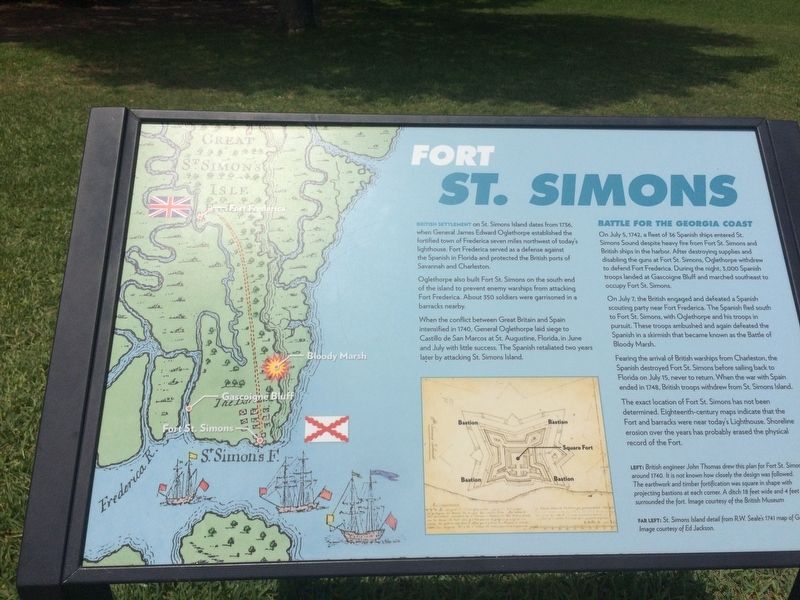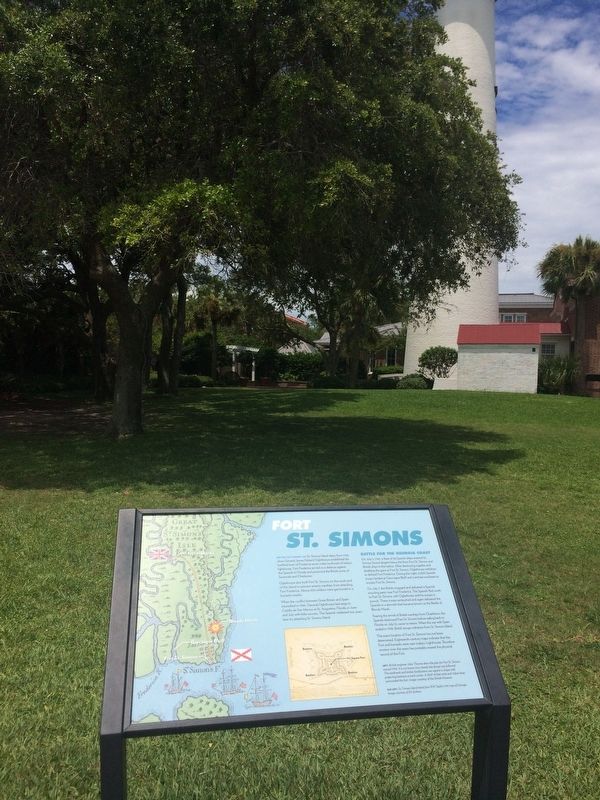St. Simons Island in Glynn County, Georgia — The American South (South Atlantic)
Fort St. Simons
British settlement on St. Simons Island dates from 1736 when General James Edward Oglethorpe established the fortified town of Frederica seven miles northwest of today's lighthouse. Fort Frederica served as a defense against the Spanish in Florida and protected the British ports of Savannah and Charleston.
Oglethorpe also built Fort St. Simons on the south end of the island to prevent enemy warships from attacking Fort Frederica. About 350 soldiers were garrisoned in barracks nearby.
When the conflict between Great Britain and Spain intensified in 1740, General Oglethorpe laid siege to Castillo de San Marcos at St. Augustine, Florida in June and July with little success. The Spanish retaliated two years later by attacking St. Simons Island.
Battle for the Georgia Coast
On July 7, the British engaged and defeated a Spanish scouting party near Fort Frederica. Spanish fled south to Fort St. Simons, with Oglethorpe and his troops in pursuit. These troops ambushed and again defeated the Spanish in a skirmish that became known as the Battle of Bloody Marsh.
Fearing the arrival of British warships from Charleston, the Spanish destroyed Fort St. Simons before sailing back to Florida on July 15, never to return. When the war with Spain ended in 1748, British troops withdrew from St. Simons Island.
The exact location of Ft. St. Simons has not been determined. Eighteenth-century maps indicate that the Fort and barracks were near today's Lighthouse. Shoreline erosion over the years has probably erased the physical record of the Fort.
Topics. This historical marker is listed in these topic lists: Colonial Era • Forts and Castles • Wars, Non-US. A significant historical date for this entry is July 5, 1742.
Location. 31° 8.033′ N, 81° 23.633′ W. Marker is on St. Simons Island, Georgia, in Glynn County. Marker can be reached from Beachview Drive. Located on the seaward side of the St. Simons lighthouse grounds. Touch for map. Marker is at or near this postal address: 618 Beachview Drive, Saint Simons Island GA 31522, United States of America. Touch for directions.
Other nearby markers. At least 8 other markers are within walking distance of this marker. The First Lighthouse ~ 1810 (within shouting distance of this marker); The Historic St. Simons Light Station (within shouting distance of this marker); Early History of St. Simons Island (within shouting distance of this marker); Historic St. Simons Lighthouse (within shouting distance of this marker); a different marker also named Fort St. Simons (within shouting distance of this marker); Couper's Point (within shouting distance of this marker); a different marker also named Fort St. Simons (within shouting distance of this marker); Keepers of the Light (within shouting distance of this marker). Touch for a list and map of all markers in St. Simons Island.
Related marker. Click here for another marker that is related to this marker. Battle of the Bloody Marsh
Credits. This page was last revised on November 23, 2020. It was originally submitted on July 29, 2017, by Steve Masler of Memphis, Tennessee. This page has been viewed 397 times since then and 22 times this year. Photos: 1, 2. submitted on July 29, 2017, by Steve Masler of Memphis, Tennessee. • Bill Pfingsten was the editor who published this page.

